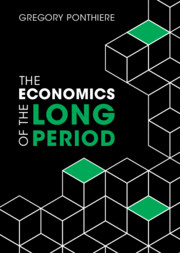Refine search
Actions for selected content:
26944 results in Economic history
Copyright page
-
- Book:
- The Economics of the Long Period
- Published online:
- 11 August 2022
- Print publication:
- 25 August 2022, pp iv-iv
-
- Chapter
- Export citation
9 - Lifestyles and the Natural Environment
- from Part III - Unified Growth Theory
-
- Book:
- The Economics of the Long Period
- Published online:
- 11 August 2022
- Print publication:
- 25 August 2022, pp 204-223
-
- Chapter
- Export citation
1 - A Brief History of Long-Run Economic Analysis
- from Part I - The Long Period
-
- Book:
- The Economics of the Long Period
- Published online:
- 11 August 2022
- Print publication:
- 25 August 2022, pp 9-31
-
- Chapter
- Export citation
7 - Economic Growth and Education
- from Part III - Unified Growth Theory
-
- Book:
- The Economics of the Long Period
- Published online:
- 11 August 2022
- Print publication:
- 25 August 2022, pp 159-184
-
- Chapter
- Export citation
2 - Empirical Elements
- from Part I - The Long Period
-
- Book:
- The Economics of the Long Period
- Published online:
- 11 August 2022
- Print publication:
- 25 August 2022, pp 32-48
-
- Chapter
- Export citation
5 - Institutions and Distribution
- from Part II - Unified Growth Theory
-
- Book:
- The Economics of the Long Period
- Published online:
- 11 August 2022
- Print publication:
- 25 August 2022, pp 102-129
-
- Chapter
- Export citation
3 - The Stagnation Regime
- from Part II - Unified Growth Theory
-
- Book:
- The Economics of the Long Period
- Published online:
- 11 August 2022
- Print publication:
- 25 August 2022, pp 51-78
-
- Chapter
- Export citation
Part II - Unified Growth Theory
-
- Book:
- The Economics of the Long Period
- Published online:
- 11 August 2022
- Print publication:
- 25 August 2022, pp 49-156
-
- Chapter
- Export citation
References
-
- Book:
- The Economics of the Long Period
- Published online:
- 11 August 2022
- Print publication:
- 25 August 2022, pp 232-236
-
- Chapter
- Export citation
6 - The Natural Environment
- from Part II - Unified Growth Theory
-
- Book:
- The Economics of the Long Period
- Published online:
- 11 August 2022
- Print publication:
- 25 August 2022, pp 130-156
-
- Chapter
- Export citation
Contents
-
- Book:
- The Economics of the Long Period
- Published online:
- 11 August 2022
- Print publication:
- 25 August 2022, pp v-ix
-
- Chapter
- Export citation
Tables
-
- Book:
- The Economics of the Long Period
- Published online:
- 11 August 2022
- Print publication:
- 25 August 2022, pp xii-xii
-
- Chapter
- Export citation
Part III - Unified Growth Theory
-
- Book:
- The Economics of the Long Period
- Published online:
- 11 August 2022
- Print publication:
- 25 August 2022, pp 157-231
-
- Chapter
- Export citation
Introduction
-
- Book:
- The Economics of the Long Period
- Published online:
- 11 August 2022
- Print publication:
- 25 August 2022, pp 1-6
-
- Chapter
- Export citation
Figures
-
- Book:
- The Economics of the Long Period
- Published online:
- 11 August 2022
- Print publication:
- 25 August 2022, pp x-xi
-
- Chapter
- Export citation
4 - The Economic Take-Off
- from Part II - Unified Growth Theory
-
- Book:
- The Economics of the Long Period
- Published online:
- 11 August 2022
- Print publication:
- 25 August 2022, pp 79-101
-
- Chapter
- Export citation
RHE series 2 volume 40 issue 2 Cover and Back matter
-
- Journal:
- Revista de Historia Economica - Journal of Iberian and Latin American Economic History / Volume 40 / Issue 2 / September 2022
- Published online by Cambridge University Press:
- 12 August 2022, pp. b1-b2
- Print publication:
- September 2022
-
- Article
-
- You have access
- Export citation
RHE series 2 volume 40 issue 2 Cover and Front matter
-
- Journal:
- Revista de Historia Economica - Journal of Iberian and Latin American Economic History / Volume 40 / Issue 2 / September 2022
- Published online by Cambridge University Press:
- 12 August 2022, pp. f1-f3
- Print publication:
- September 2022
-
- Article
-
- You have access
- Export citation

The Economics of the Long Period
-
- Published online:
- 11 August 2022
- Print publication:
- 25 August 2022
24 - What Was the Great Leap Forward?
-
- Book:
- Our Long Walk to Economic Freedom
- Published online:
- 30 August 2022
- Print publication:
- 04 August 2022, pp 141-146
-
- Chapter
- Export citation
